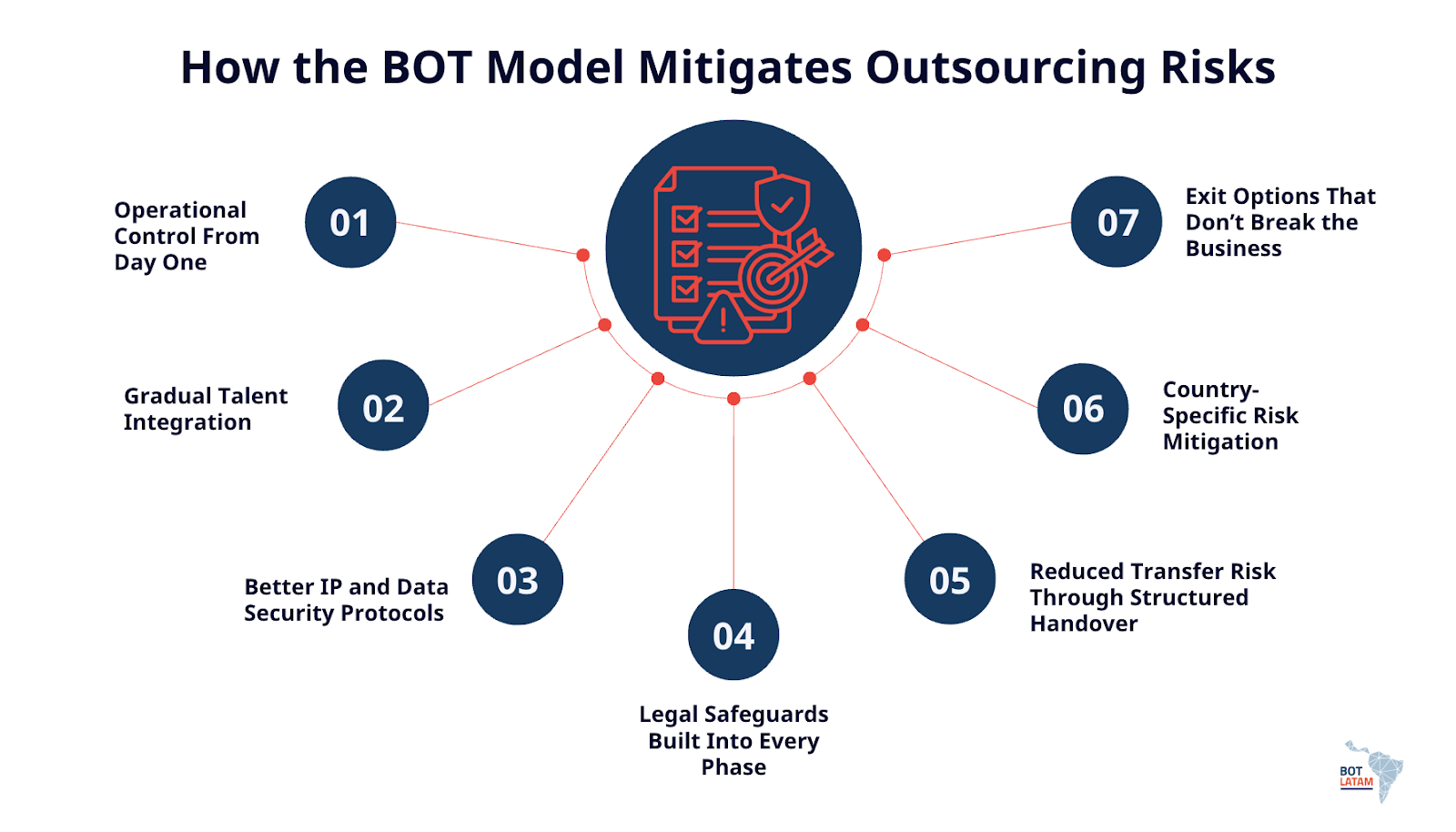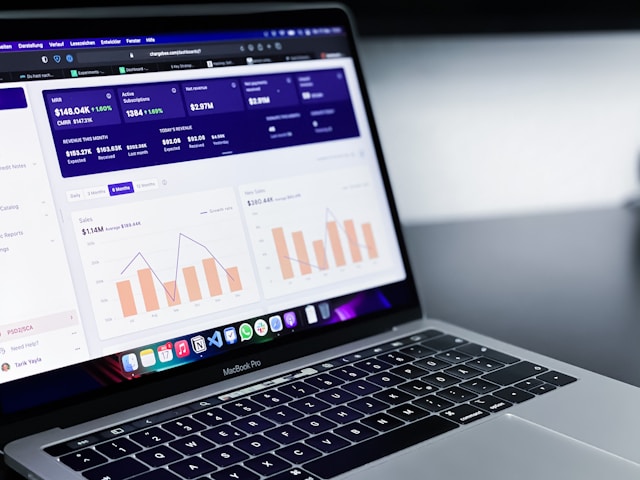Outsourcing software development to Latin America comes with big advantages, cost savings, time zone alignment, and access to top talent. But it also brings real risks… Data security, team turnover, and inconsistent delivery can derail even the best-laid plans.
That’s where the Build-Operate-Transfer (BOT) model comes in. This nearshore strategy gives companies more control while gradually transferring operations, reducing the typical outsourcing risks along the way. Considering that nearly 63% of organizations cite risk management as a top priority in global sourcing strategies, according to Deloitte’s Global Outsourcing Survey. If you're considering outsourcing in Latin America, the BOT model may offer the risk mitigation strategy you’ve been looking for.
In this article, you’ll learn exactly how the BOT model reduces risk in nearshore software development. You’ll get practical tips on BOT risk management, see how it stacks up against other outsourcing models, and explore real-world examples from across LATAM.
How the BOT Model Mitigates Outsourcing Risks

The Build-Operate-Transfer (BOT) model is built for control and risk reduction. Unlike traditional outsourcing, where you hand off entire operations to a vendor, BOT gives you phased ownership. That alone lowers the risk of misalignment or poor execution.
1. Operational Control From Day One:
With BOT, you retain visibility into workflows, quality benchmarks, and timelines. The service provider sets up and runs the operation during the “Operate” phase, but under your governance. This keeps your development aligned with internal goals while avoiding the chaos that often comes with handing off too much, too soon.
2. Gradual Talent Integration:
Instead of relying on a vendor’s offshore team indefinitely, you build your team that will eventually be transferred. That reduces long-term dependency on third-party labor. You can review hiring pipelines, enforce skill requirements, and shape company culture from the beginning.
3. Better IP and Data Security Protocols:
One of the top outsourcing risks in LATAM is data protection, especially with increasing global scrutiny on IP laws. The BOT model allows for custom security setups and full compliance with international standards like ISO 27001 and GDPR. This is far more effective than relying on a generic vendor policy.
4. Legal Safeguards Built Into Every Phase:
From the initial build to final transfer, BOT structures are designed to include legal frameworks that protect your IP, enforce SLAs, and maintain compliance. According to Gartner, companies using structured outsourcing models like BOT see a 30% lower risk of contract disputes than those in traditional vendor relationships.
5. Reduced Transfer Risk Through Structured Handover:
The phased transition makes knowledge transfer seamless. You’re not inheriting a team cold; you’ve already worked with them. That smooth handover reduces the chance of codebase confusion, process mismatch, or unscalable tech infrastructure.
6. Country-Specific Risk Mitigation:
LATAM markets vary widely. A BOT setup can be customized to local labor laws, tax incentives, and business customs. That gives you a strategic edge and reduces legal or operational surprises. For example, Colombia offers free trade zones that reduce employer costs, while Mexico enforces strict labor laws that must be planned for during the Operate phase.
7. Exit Options That Don’t Break the Business:
If the engagement doesn’t go as planned, the BOT model allows for controlled exit strategies without the sunk cost of fully owned infrastructure. This flexibility is often missing in captive centers or long-term traditional outsourcing agreements.
Why BOT Reduces Risk Better Than Other Outsourcing Models
Defined Handover Timeline Minimizes Operational Surprises:
BOT contracts are built around a defined transition. The end goal is clear: transfer the operation to your ownership. Traditional models often lack that roadmap, making the exit strategy vague or costly.
A structured BOT handover includes personnel transfer, tech documentation, regulatory compliance, and vendor disengagement plans. That predictability makes scaling safer and more sustainable. In contrast, exiting traditional outsourcing agreements can trigger legal issues and infrastructure loss.
Long-Term Cost Certainty:
Over time, the BOT model becomes more cost-efficient than long-term outsourcing. Instead of paying perpetual markups or hourly rates, you take over a fully functioning operation. That reduces vendor overhead, improves budgeting accuracy, and limits surprise costs.
Local Compliance Built In:
BOT structures are adapted to local laws from the start. Labor contracts, tax structures, and corporate registrations are handled with a transfer plan in mind. This reduces regulatory risk, especially in complex markets like Brazil or Argentina.
In traditional outsourcing, you may never gain full visibility into compliance practices. That opacity can be risky if laws change or audits occur. BOT gives you both transparency and adaptability, two key tools for long-term resilience in LATAM.
Reduced Dependency on External Vendors:
The longer you outsource to a third party, the more you rely on their systems, processes, and staff. That vendor dependency becomes a risk if costs rise, service drops, or the partner exits the market.
BOT Model Risk Management Best Practices
1. Align BOT Objectives With Business Strategy:
Make sure the BOT model fits into your broader goals from day one. Don’t treat it as just a hiring shortcut. Define what success looks like, including cost savings, speed to market, and IP security, and match each BOT phase to those outcomes. According to KPMG, 53% of failed outsourcing initiatives lacked alignment between sourcing decisions and business strategy.
2. Establish Local Legal and Compliance Safeguards:
Use local legal counsel familiar with labor laws, tax codes, and IP protections in the chosen LATAM country. A misstep here could lead to fines or transfer delays. Brazil, for instance, has strict regulations under LGPD (its version of GDPR). Ensure your contracts are enforceable locally, not just in your home country.
3. Build Transparent Governance and Reporting Structures:
Transparency matters. Design reporting protocols that cover KPIs, team performance, budget tracking, and escalation paths. Weekly cadence reports and shared dashboards reduce blind spots. McKinsey found that companies with clear governance models are 40% more likely to meet outsourcing objectives.
4. Prioritize Shadowing and Cross-Team Knowledge Sharing:
Use the Operate phase to introduce knowledge transfer rhythms. Encourage embedded collaboration between your in-house team and the nearshore unit. Pair programming, shared sprint planning, and shadowing reduce transition risk later.
5. Limit Tech Debt by Controlling Initial Architecture:
Even if the partner is leading the build phase, set standards for code quality, documentation, and scalability. Define the tech stack in your terms. Mandate version control, CI/CD practices, and unit testing from the start. Poor architectural decisions in this stage can become costly during the transfer.
6. Manage Talent Retention With Shared Ownership:
Shared investment in team development pays off. Ask your BOT partner to implement benefits, learning paths, and clear career ladders for developers. High turnover erodes value fast. In LATAM, average software developer attrition can reach 25% annually without long-term incentives, according to Accelerance.
7. Define Exit and Handover Criteria Early:
Document your transfer plan before the build begins. That includes tech documentation, system access rights, HR transitions, and knowledge transfer timelines. Include specific “trigger events” that initiate the transfer phase. Leaving this vague increases legal and operational risk.
8. Use Third-Party Audits for Quality and Compliance:
Don’t rely solely on your BOT partner’s reports. Schedule periodic audits, tech reviews, compliance checks, and security scans by independent third parties. This keeps everyone accountable and uncovers issues before the transfer begins.
9. Localize Risk Planning:
Each LATAM country brings different risk vectors. Colombia’s infrastructure is solid in urban centers but less reliable in remote areas. Argentina faces currency volatility that can affect payroll and retention. Tailor your risk mitigation to local realities, not a one-size-fits-all model.
10. Create Layered Data Protection Protocols:
Security breaches can be costly. Set up access controls, endpoint protection, and internal firewalls from day one. Avoid shared credentials. The average cost of a data breach in LATAM reached $2.46 million in 2023, according to IBM Security. Ensure SOC 2 compliance or ISO 27001 certification where applicable.
Ready to Get Started With the BOT Model?
Reducing outsourcing risk in LATAM requires more than just vendor selection, it demands structural control, legal clarity, and long-term team ownership. The Build-Operate-Transfer model makes that possible by aligning nearshore delivery with enterprise-level governance.
At BOT LATAM, we specialize in helping companies launch nearshore operations in Latin America using a low-risk, phased BOT approach. Our team manages the build and operate phases with full compliance, localized HR strategy, and transparent KPIs, so when it's time to transfer, you're taking over a fully optimized unit.
We combine local legal insight, on-the-ground recruiting, and enterprise-grade process design to give your team the control it needs without the uncertainty. If you're looking to de-risk nearshore software development while still gaining speed and scale, we can be your strategic partner for sustainable success in the region. Contact us to schedule a discovery call today!

Revolutionize Your Workflow with Our Innovative BOT Strategy!
Enhance your operations seamlessly and adapt to market demands
Contact Us

.jpg)


%2017.26.38.png)